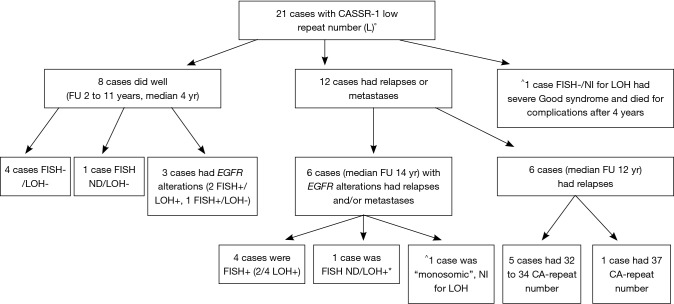Figure 3.
Integrated correlation of molecular and genetic data and clinicopathological features in 21 cases with low-number (“L”) CA-SSR-1 CA repeats (FU ≥2 yr). All WHO histotypes were represented with B2 to B3 cases representing the majority. Cases “L” which did well: no. 6, 21, 22, 25, 32; cases which did well but had egfr gene alterations: no. 27, 31, 33. Cases “L” which had relapse or metastases and had egfr alterations: no. 10, 40, 41, 42, 43; case no. 36 was “monosomic”. Cases “L” which had relapse or metastases, no detectable egfr gene alterations but had short CA-SSR-1 microsatellite: no. 5, 19, 26, 30, 37. Case “L” which had relapse or metastases, with no detectable egfr alterations and CA-SSR-1 microsatellite 37 repeat long: no. 29. The case “L”, FISH-/Not Informative for LOH with Good’s syndrome which had combined CA-SSR-1 microsatellite length of 36 was no. 17. *In this LOH+ case “(+) >”, with LOH of the shorter allele, the FISH status could not be determined (case No. 40, Table 2); ^NI for LOH = not Informative for LOH study (cases No. 17 and 36); Cases 18 and 28 (early deaths) were not reported here. LOH, loss of heterozygosity; FISH, fluorescent in situ hybridization.

